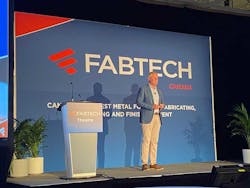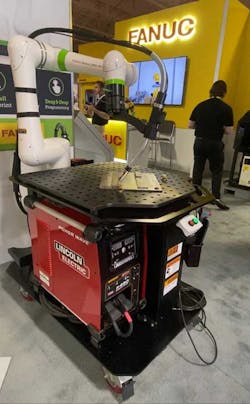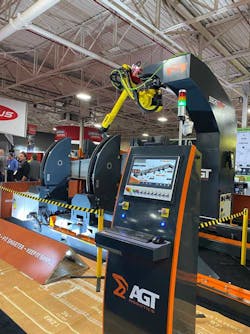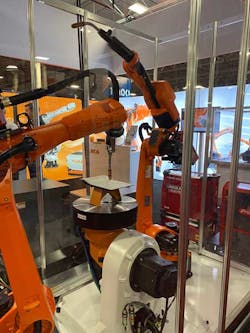FABTECH Canada 2022 Makes a Comeback After Four Years
At a Glance:
- During a keynote at FABTECH Canada 2022, Dr. Jason Myers, CEO of NGen (Next Generation Manufacturing Canada), unpacked the challenges Canadian manufacturers face relative to their largest trading partner.
- Innovation, digital platforms, connectivity, automation and collaboration are vital to industrial transformation.
- When it comes to the economics of manufacturing, business practices in Canada and the U.S. are not one and the same.
FABTECH Canada was already underway when Canada’s Federal Government announced it was suspending its mandatory COVID-19 vaccine mandates and random testing requirements for air and rail travellers. News of the policy change would be a welcome development for FABTECH Canada (June 14-16) attendees who congregated face-to-face for the first time in four years since the pandemic put a damper on in-person events.
Held at the Toronto Congress Centre, the show was located just minutes from Pearson International Airport, making it a convenient meeting place for fabricators and welders who return to the show every two years to network with industry suppliers, original equipment manufacturers, importers and thought leaders from around the globe. Close to 40 technology focus areas were represented at this year’s event, including cutting, lasers, press brakes, robotics and welding machines.
Straddling 80,000 sq. ft. and accommodating more than 200 exhibiting companies, the Canadian show is small relative to its American counterpart. In 2015, FABTECH Chicago took up 732,000 sq. ft. and topped 40,000 in attendance. Is it any wonder the bi-annual event series is billed as North America’s largest destination for purveyors of metal forming, fabricating, tube & pipe, welding and finishing?
Engaging Keynote and Leadership Exchange
More than 50 conference sessions, workshops and breakout sessions on cutting, laser, finishing, forming & fabricating, automation and smart manufacturing, additive manufacturing and workforce development were present for the three-day event. Sessions were designed to explore what’s new and upcoming, to address today’s biggest challenges and to improve productivity.
Canada’s Challenges
The brunt of the industry challenges, albeit from a Canadian perspective, were laid out in a keynote by Dr. Jason Myers, CEO of NGen (Next Generation Manufacturing Canada), an industry-led non-profit that leads Canada’s Advanced Manufacturing Supercluster.
“We’ve got a big skills issue in Canada,” Myers said. “In manufacturing, overall, 20% of the workforce today will be retired by 2030. The cohort that is under 30 and coming into manufacturing, or the youngest cohort in the industry, represents about 6% of the total workforce. You can do the math.
“If we remain where we are in terms of current production levels in the country, let alone grow, we’re going to have to increase productivity by about 25% between now and 2030,” he added. “We’re not only facing labor shortages in manufacturing, we’re going to be facing really severe skill shortages as well, because that need to boost productivity is going to drive automation needs.”
In other words, if automation is viewed as a solution to the labor problem, Canada’s labor pool will require different types of skills to match the ability to work with new technology and to use it productively, as well as in accordance with “good business objectives in terms of competitiveness and growth,” Myers clarified.
Playing to Strengths
Canada’s electric vehicle value chain is a good example in highlighting some of the challenges the industry faces. “First of all, the industry today is totally unsustainable,” explained Myers, who served as president and CEO of Canadian Manufacturers and Exporters, Canada’s largest industry and trade association between 2007 and 2016.
“Batteries don’t live that long,” he continued. “They don’t go that far. They don’t work that well in cold weather. And here’s the real problem: There aren’t enough product engineers in the world to design, develop and test all of the materials and components and powertrain motors and the electronics and the vehicles for the EVs that have already been announced. So how do we solve those really important innovation challenges?”
Making sure that manufacturers’ R&D and production systems are supported is where NGen’s expertise comes in. The organization invests in advanced manufacturing clusters to support companies and research organizations in the fields of additive manufacturing, robotics and automation and the manufacturing of personal protective equipment.
More to the point, NGen focuses on solving long-term problems by funding the scale-up of full-scale production of devices and technologies. “That’s a really important part of Canada’s innovation system,” said Myers. “It’s often forgotten how important it is to be able to present to manufacturers a technology that is part of an integrated engineering solution, that is cost-effective, cost-competitive and that they can actually deploy in their own operations.”
The master narrative is that not only are market conditions are changing, but the business of manufacturing is changing as well. This scenario was evident when Myers visited one of the world’s largest trade fairs, Hannover Messe, in the early part of June.
But solutions cannot be one-size-fits-all, warned Myers. “Companies need to focus on the solution they’re providing customers; your customers’ customers should be a part of the [manufacturing] customer success story,” he advised. “And that’s a very different type of business model than simply getting product out the door. A product is not a solution unless it can be managed, unless it’s cost competitive, and, frankly, unless your customer sees value.”
For Myers, innovation is the core to solving some industrial problems and enterprises need to focus on value-adding propositions, as well as on being flexible and agile. In order to respond rapidly to changing conditions, he said, innovation is integral to problem solving, as is focusing on the right products and processes.
Canada and the U.S. are Not One and the Same
Canada’s real strategic advantage is not necessarily in the technology itself. “In my mind, it’s about strategy,” said Myers. “It’s about identifying opportunity. It’s about differentiation, about process excellence, about continuous improvement and about getting the technology to do the job.”
Myers, a business economist whose specialization is industrial and technological change, made plain that this may not be the strategy for European, Chinese or U.S. companies. The U.S. is Canada’s largest trading partner, but it does not have the same manufacturing structure as the United States, he reminded the FABTECH audience. “We have a lot of small companies, and very few midsize and large companies. Our strategic advantage is not based on volume, but it is based on solutions and engineering, and the ability of Canadian companies to quickly develop solutions, bring them to their customers, and to do that in a very responsive, agile way. That has been our success to date.”
Productivity by any Measure
Canada measures productivity differently than the United States, where productivity measures tend to favor high-volume production, explained Myers. In turn, Canadians measure productivity based on the price or the value of the product as it leaves the factory gate after it is produced.
“If you look at every single line in a balance sheet of an American income statement, every single line that talks about gross profit before tax, profit after tax, operating profit, Canadian manufacturing outperforms, on average, the U.S. manufacturing sector. I think it is because we are focused on solutions and engineering.”
Myers offered a rudimentary description of the differences in measuring productivity. “We measure the value based on the price or the value of the product as it leaves the factory gate after its produced,” he said. “The U.S. takes a different approach. They look at manufacturing companies and they simply subtract their input costs, services, products and energy from that. So, the U.S. measure actually takes into consideration the services that are being provided around the product. We’re just measuring the product itself.”
He added that, by definition, the product itself is becoming less valuable in relative terms to the services that are being generated by companies around the world and around the product.
Integration is a Driving Force
The rapid integration of services into solutions, networking architectures and the ability to make systems interoperable create opportunities by offering new capabilities and by requiring companies to operate in very different ways, noted Myers. “Look around at just about every product and every process today,” he said. “Is it a data platform? It is how companies can use that data to provide additional revenue streams, additional services, that are going to be a market success for those companies that are going to prosper and grow over the next several years. Technologies, of course, are changing the entire environment.”
Co-located Conference
With its focus on current issues facing the industry, Myers' keynote provided a fitting backdrop for both FABTECH Canada and the co-located CanWeld 2022 Conference (June 15-16).
CanWeld is operated by the CWB Group, an industry supported sector organization that provides welding certification, management systems registration and training services to the welding industry.
FABTECH Canada’s event partners are FMA (Fabricators & Manufacturers Association, International), SME, Precision Metalforming Association (PMA), Chemical Coaters Association International (CCAI) and the American Welding Society (AWS).
About the Author

Rehana Begg
Editor-in-Chief, Machine Design
As Machine Design’s content lead, Rehana Begg is tasked with elevating the voice of the design and multi-disciplinary engineer in the face of digital transformation and engineering innovation. Begg has more than 24 years of editorial experience and has spent the past decade in the trenches of industrial manufacturing, focusing on new technologies, manufacturing innovation and business. Her B2B career has taken her from corporate boardrooms to plant floors and underground mining stopes, covering everything from automation & IIoT, robotics, mechanical design and additive manufacturing to plant operations, maintenance, reliability and continuous improvement. Begg holds an MBA, a Master of Journalism degree, and a BA (Hons.) in Political Science. She is committed to lifelong learning and feeds her passion for innovation in publishing, transparent science and clear communication by attending relevant conferences and seminars/workshops.
Follow Rehana Begg via the following social media handles:
X: @rehanabegg
LinkedIn: @rehanabegg and @MachineDesign




